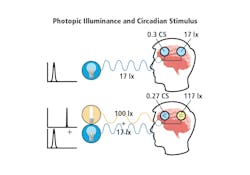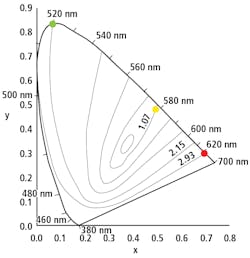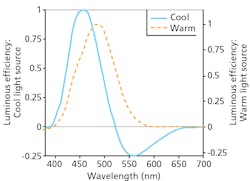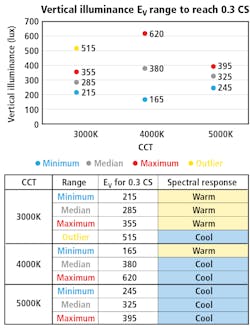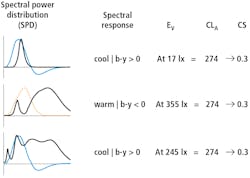As discussed in the previous article of the circadian light series, “Industry must move beyond CCT to articulate circadian metrics,” a wide range of photopic illuminance levels at the eye may be required to reach a specific circadian stimulus (CS), even for light sources of the same correlated color temperature (CCT). Since we know the circadian system to be a “blue-sky detector,” it may be generally true that cooler light-source spectra (>4000K) require a lower illuminance at the eye than warm light-source spectra (<4000K) to stimulate the circadian system. However, this is certainly not always the case. Indeed, as demonstrated in the previous article, different 4000K light sources can be both the most and the least efficient at stimulating the human circadian system. In this article, we will explain why this is the case.
Consider a blue LED (λmax = 486 nm) that produces 17 lx at the eye — this gives a CS = 0.3. If one were to add 100 lx of low-pressure sodium (LPS) to make the combined light appear “white” (CCT = 3241K), the total illuminance at the eye would obviously be 117 lx, but counterintuitively, the circadian effectiveness of the combined light would drop to CS = 0.27 (Fig. 1). This is known as subadditivity — in other words, 1 + 1 < 2! Shocking, perhaps, but it shouldn’t be to those familiar with brightness perception. The same basic mechanism that governs brightness perception also influences the effectiveness of circadian light, which will be covered shortly.
Color vision and brightness perception
For humans, color vision has three dimensions (Fig. 2), each defined by a different neural channel. The first channel is the achromatic (black-and-white) channel that simply adds all the flux incident on the retina — the more flux on the retina, the brighter the light will be, if it has no apparent hue. Hue is handled by two chromatic channels — one that responds to light as blue or yellow (or nothing if it is black or white), and one that responds to light as red or green (or nothing if it is black or white).
The two chromatic channels — blue versus yellow (b-y) and red versus green (r-g) — are spectrally opponent, meaning that a greenish red or a bluish yellow cannot exist. All hues we see are combinations of these two spectrally-opponent channel outputs so we can see a greenish blue (turquoise) or a bluish red (purple), for example.
Brightness perception is determined by these two chromatic channels as well as an achromatic, black-and-white channel. When more light is added to the retina, the achromatic channel increases its response. If that light has a hue, it will appear brighter than a white light that produces the same response in the achromatic channel. For example, a red light of 100 lx will look brighter than a white light of 100 lx because its red hue contributes to brightness perception. Because the color channels are spectrally opponent, adding a green light to the red light can make the red light appear less bright even though the achromatic channel increases.
What’s an example of subadditivity?
As a specific example, 100 lx of light emitted by a red LED will appear equally as bright as 150 lx from a green LED (Fig. 3). If these two lights are combined, the achromatic illuminance at the eye will be 250 lx and its hue will appear yellow. Remarkably, the resulting yellow light of 250 lx will actually appear less bright than either the red light alone at 100 lx or the green light alone at 150 lx. This is a clear example of subadditivity. The reason behind this surprising outcome is that perceived brightness of a light depends not only on its achromatic light level but also on its apparent hue. Red and green lights are more “hueful” than a yellow (or white) light. The same basic physiology contributes to circadian light.
How does the b-y channel impact circadian response?
The intrinsically photosensitive retinal ganglion cells (ipRGCs) represent the lynchpin between the retina and the biological clock, linking the external 24-hour light dark cycle to our internal rhythms of behavior and physiology. As the name implies, ipRGCs contain the photopigment melanopsin that absorbs light and generates a neural signal for the biological clock. Without ipRGCs, our physiology and behavior would no longer be synchronized with sunrise and sunset. Experiments have shown that as long as the ipRGCs are intact, even without the photopigment melanopsin, light can still synchronize our biological clock to the daily light-dark cycle by neural signals from the rods and cones (photoreceptors responsible for vision). There is no direct connection between these photoreceptors and the ipRGCs — rather, their signals are processed by a variety of neural circuits before reaching the ipRGCs. One of these neural circuits is a spectrally-opponent chromatic channel that also affects brightness perception. Specifically, the spectrally-opponent blue-yellow channel processes cone signals before reaching the ipRGC. This is why the blue LED delivering 17 lx at the eye becomes less effective for the circadian system when 100 lx of LPS is added — the effectiveness of the blue LED for stimulating the ipRGC is reduced by adding yellow LPS.
Quantifying circadian response
As for creating metrics to quantify circadian response, the Lighting Research Center (LRC) uses circadian light (CLA) and circadian stimulus (CS; see the first installment in this series, which defines the terminology). Subsequently, the research team has developed a computational model that includes subadditivity. The spectral sensitivity of the modeled circadian circuit in the eye for one achromatic light level can be graphed with two curves (Fig. 4). It is a two-state model — one for white light sources where the b-y channel balance tilts to signal “blue” or for another light source where it tilts to signal “yellow.” These white sources would appear cool or warm, respectively, but again the CCT designation will not necessarily be related to the actual appearance of the light.
Response curves in action
Recalling the summary from the previous article, the photopic illuminance level at the eye needs to reach a target CS of 0.3 for light sources categorized by their CCTs of 3000K, 4000K, and 5000K (Fig. 5, top).
The corresponding table in Fig. 5 indicates on which side of the b-y channel — warm or cool — a given light source falls. One 3000K light source has a cool spectral response unlike the others, and one 4000K light source has a warm spectral response. With regard to all warm sources, the spectral sensitivity of the circadian system (yellow dashed line in Fig. 4) is governed almost exclusively by melanopsin in the ipRGCs. For cool sources, however, subadditivity will come into play as illustrated by the positive and negative lobes of the solid blue line in Fig. 4. Again, adding a yellow light in the negative region to a blue light in the positive region will reduce the circadian effectiveness of the combined light relative to the blue light alone.
In Fig. 6, the spectral power distributions (SPDs) of a blue LED, a 3000K LED (“Maximum”), and a 5000K LED (“Minimum”) are indicated by the black curves, accompanied by the respective modeled spectral sensitivity responses indicated by the blue or yellow curves. Different combinations of spectra and vertical illuminance are required to reach the target CS of 0.3.
This is fairly complicated! But the concepts are important to advancing the science behind applying circadian lighting principles. However, now that these complexities have been established, it should be relieving to know that a lighting manufacturer or designer does not need to know all of the intricacies of retinal neurophysiology to provide circadian light to building occupants. The final article of the series will go more into depth on the adaptation of the new language into application.
Get to know our expert
ALLISON THAYER, MS, BA, is a research specialist at the Lighting Research Center (LRC), formerly part of Rensselaer Polytechnic Institute. She holds a bachelor’s in architecture, and a master’s of science with a concentration in lighting from Rensselaer. Thayer has played a main role in the development of the structure and content of the Healthy Living website.
For up-to-the-minute LED and SSL updates, why not follow us on Twitter? You’ll find curated content and commentary, as well as information on industry events, webcasts, and surveys on our LinkedIn Company Page and our Facebook page.
